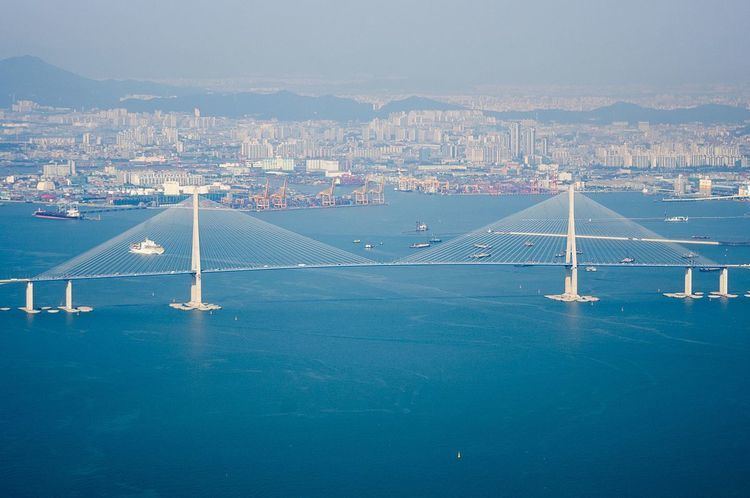Carries 6-lane expressway Design Cable-stayed bridge Longest span 800 metres (2,600 ft) Total length 18,384 m Height 230 m | Width 33.4 metres (110 ft) No. of spans 5 Construction started 2005 Clearance below 74 m | |
 | ||
Similar Yeongjong Bridge, Yeongjongdo, Songdo Central Park, Port of Incheon, Muuido Profiles | ||
Incheon bridge construction
The Incheon Bridge (인천대교 Incheon-daegyo) is a reinforced concrete bridge in South Korea. At its opening in October 2009, it became the second connection between Yeongjong Island and the mainland of Incheon. The Incheon Bridge is South Korea's longest spanning cable-stayed bridge. In comparison, the Incheondaegyo is the world's seventh longest cable-stayed bridge as of October 2010. The main purpose of the bridge is to provide direct access between Songdo and Incheon International Airport, reducing travel time between them by up to one hour.
Contents
The sea crossing bridge section, whose concessionaire is Incheon Bridge Corporation, is funded by the private sector. Korea Expressway Corporation and the Korean Ministry of Land, Transport and Maritime Affairs (MLTM) managed the project.
Incheon bridge hd may 2010
Construction
The main design and build contractor was (Samsung C&T Corporation JV (Daelim, Daewoo, GS, Hanjin, Hanwha, Kumho)). Total costs were ₩2.45 trillion, including federal funded approach roads. The 21.38 kilometres (13.3 mi) long highway project consisted of government-built sections at three ends and a 12.34 kilometres (7.7 mi) section in the middle built with private capital, the bridge section is 18,384 metres (60,315 ft) long. The bridge has a cable stayed section over the main sea route to Incheon port. This was the most difficult part to construct, with a main tower 230.5 metres (756.2 ft) high, vertical clearance of 74 m (243 ft), and five spans: a centre span of 800 m (2,625 ft) flanked on either side by spans of 260 m (853 ft) and 80 m (262 ft). Adjacent to the center section are approach spans consisting of a series of 150 m (492 ft) balanced cantilever spans. Lower level viaducts consisting of 50 m (164 ft) spans connect to land at each end of the bridge.
Design
Because the bridge is situated in a known seismically-active region, a seismic design of the substructure was adopted.
At 12.3 km long with a main cable stayed span of 800m the new Incheondaegyo will be one of the five longest of its type in the world. Its 33.4m wide steel/concrete composite deck will carry six lanes of traffic 74m above the main shipping route in and out of Incheon port and link the new Incheon International Airport on Yeongjong Island to the international business district of New Songdo City and the metropolitan districts of South Korea's capital, Seoul. The cable stayed section of the crossing is 1,480 m long, made up of five spans measuring 80 m, 260 m, 800 m, 260 m and 80 m respectively: height of the inverted Y main towers is 230.5 m. A 1.8 km approach span and 8.7 km viaduct complete the crossing, both constructed with precast prestressed concrete box girder decks. Foundations are drilled piles 3 m in diameter. In order to accommodate movement between the bridge decks, the Incheondaegyo was equipped with expansion joints weighing up to 50 tons per joint.
Notable Incidents
On May 20, 2010, twelve passengers were killed in a bus crash at the bridge.
